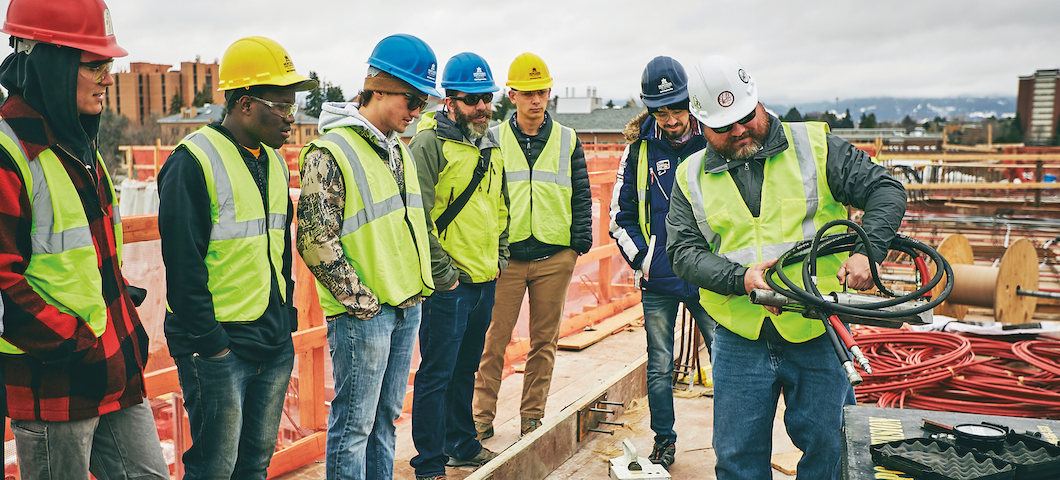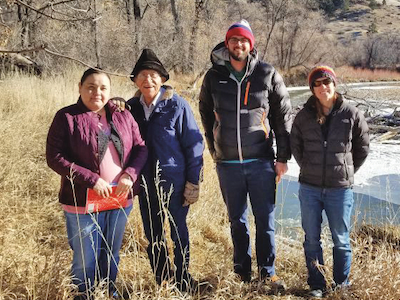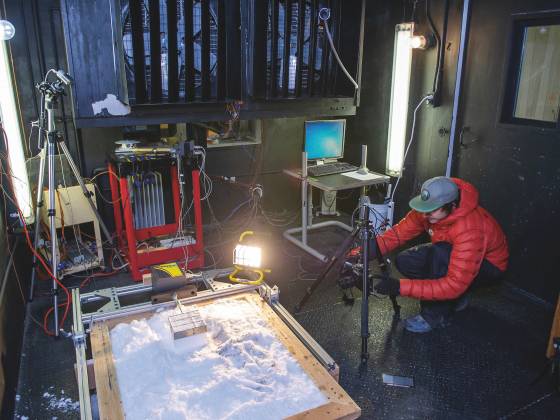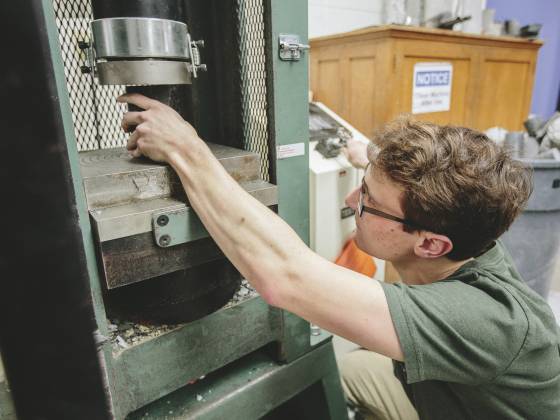Newsletter - Fall 2019

MSU civil engineering students tour the construction site of the new student dorm on campus with associate professor Michael Berry. MSU photo by Adrian Sanchez-Gonzalez
Civil Actions
- The grand opening of Norm Asbjornson Hall (NAH) occurred in December and the first classes and labs were conducted this spring. Innovative systems and materials make the NAH the most energy efficient building in Montana. The building is student focused with many spaces for formal and informal collaboration between faculty and students. And although the CE Department has largely stayed in our historic spaces in Cobleigh Hall, the Department has benefited from access to the NAH state of the art classrooms. New labs in NAH will also result in some additional lab space for the Department in Barnard Hall.
- The Department has received a $150,000 gift from the Beavers Heavy Engineering Construction Association to develop two new courses in heavy civil construction. This fall, a course on heavy civil construction practices will be facilitated by CET faculty member Bret Martin. The course will be unique in that practicing professionals from heavy civil construction companies from around the region will come to campus to deliver modules on concrete, pavements, aggregates, pipelines, tunnels, equipment management and many other topics. This new approach to course delivery will provide our students with access to practicing professionals with specific expertise. In the spring, a course on heavy civil estimating and scheduling will be offered.
- After several years of development, the Department’s Environmental Engineering (EENV) program began accepting students in January. The EENV degree replaces the Bio-resources Engineering (BREN) option. Students currently enrolled in the BREN program will be able to complete their degree or transfer in the EENV program.
Research Spotlight

Water sampling on the Crow Reservation.
Civil Engineering Department faculty continue to conduct relevant research in a wide variety of civil engineering specialties, including transportation, geotechnical, fluids, water resources, environmental, structural and engineering mechanics. This issue’s research spotlight highlights the work Dr. Ellen Lauchnor is conductingon arsenic groundwater contamination in Southcentral Montana due to both anthropogenic contamination and naturally occurring geologic sources. Health screenings of Tribal members and well water sampling on the Crow Reservation in sites historically used for livestock “dipping” in arsenical pesticides are of particular concern. The 100+ year old railroad corridor is also a concern as arsenic was used as a preservative in railroad ties and herbicides used for weed control. Dr. Lauchnor’s research will first assess the potential anthropogenic sources such as livestock dipping vats and the railroad corridor. Then the research will investigate ways to improve health by reducing Tribal members’ exposure to arsenic. This project is an example of the relevant, interdisciplinary research being conducted in the Department to improve the lives of Montana’s citizens.
Comings and Goings
Time moves on and the Department of Civil Engineering continues to change.
- Transportation professor YiYi Wang left the program this June for an opportunity in California. Structures professor and Department Head Jerry Stephens retired in December after 29 years of service. Regent’s Professor Anne Camper also retired in January after 30 years of service. Ed Adams retired in the summer of 2018. And the iconic Professor Ted Lang, who served MSU for 48 years, also retired in 2018. Anne, Jerry and Ed have been awarded Emeritus Professor status by the Board of Regents. Dr. Lang was awarded the Blue and Gold Award for his university service and also inducted into the Montana Professional Engineers Hall of Fame. These four individuals made an incredible impact on the State of Montana and on the lives of thousands of students. They will be missed.
For every retirement or departure, there are new faculty added to the Department who bring new ideas and energy to the Department. Recent new additions to the faculty include:
- Craig Woolard joined the Department as Professor and Department Head in October 2018. Prior to returning to MSU, Craig served as the Director of Public Works for the City of Bozeman. Craig has also served as the Treatment Operations Director and then General Manager of the Anchorage Water and Wastewater Utility in Anchorage, Alaska. Prior to his employment with the Anchorage utility, Craig was a Professor and Chair of the Civil Engineering program at the University of Alaska Anchorage. Craig’s research interests include water and wastewater treatment, asset management and engineering leadership. Craig has been active in professional associations throughout his career and has served as the national president for the American Water Works Association in 2008. Craig grew up in Kalispell, Montana and holds a B.S. in Civil Engineering from Montana State University and a Ph.D. in Civil Engineering from the University of Notre Dame. He is a registered professional engineer in Alaska and Montana and a graduate of Leadership Montana.
- Chris Borstad joined the faculty in January 2019 filling the position vacated by the retirement of Ed Adams. His research interests involve snow and ice mechanics, including avalanche triggering mechanics, avalanche forecasting, iceberg calving from glaciers and ice sheets, glacier flow dynamics, and numerical modeling of fracture and damage processes. Chris grew up in Fort Collins, CO and got his B.S. in Physics at Colorado State University, during which time his research interests in snow were sparked as a budding backcountry skier. Chris got his M.S. and Ph.D. in Civil Engineering at the University of British Columbia in Vancouver, Canada. He then received a NASA Postdoctoral Fellowship at the Jet Propulsion Laboratory where he worked on ice sheet modeling. In 2014, Chris moved to the northernmost town in the world to work as an Associate Professor at the University Centre in Svalbard, where he stayed until moving to Bozeman.
- Kirsten Matteson joined the Civil Engineering Department at MSU as an Assistant Professor in structures in August 2018. She has a B.S. in Civil Engineering from Embry Riddle Aeronautical University. She then attended Colorado State University (CSU) for both her M.S. and Ph.D. in the Civil and Environmental Engineering Department. Kirsten’s research has involved investigation into properties of plastic-aluminum composite I-beams and the use of the discrete element method to model surface treatments. Her current research interests include investigations of new materials and their possible applications, designing new test methods specific to new materials and developing test standards, numerical modeling composite materials, and solid mechanics. Kirsten is also the new faculty advisor for the American Society of Civil Engineers student chapter at MSU.
- Catherine Kirkland recently joined the Department in August as an Assistant Professor in the Environmental Engineering program after working as a research faculty in the Center for Biofilm Engineering on wellbore leakage mitigation using biomineral precipitation. Catherine’s research interests also include aerobic granular sludge biofilms used for wastewater treatment and nuclear magnetic resonance (NMR) methods. Catherine has applied NMR to detect biofilms and biomineralization in the subsurface and to explore the structure – function relationship in granular biofilms. She earned a Ph.D. in Environmental Engineering from Montana State University. Prior to graduate school, Catherine worked as an engineer for Genesis Engineering in Bozeman, focusing on onsite wastewater treatment systems, stormwater design, floodplain permitting, and subdivision approvals. She also earned a B.A. in Anthropology and Sociology from Rhodes College. Catherine has ongoing collaborative relationships with colleagues at Delft University of Technology in the Netherlands, University of Stuttgart and RWTH – Aachen University in Germany, Aberystwyth University in Wales, and with industrial partners in the oil and gas and wastewater treatment industries.
- Mohamed Khosravi joined the faculty in August 2018 in the geotechnical area to replace the vacancy left by Bob Mokwa when he became MSU’s Provost. He holds a B.S. in Civil Engineering from Sharif University of Technology, and a Ph.D. in Civil Engineering from Virginia Tech. His scholarly interests focus on geotechnical earthquake engineering with emphases on liquefaction, ground improvement, seismic performance of earth dams and levees, and seismic soil-pile-structure interaction.He is also interested in cold regions infrastructure with an emphasis on developing sustainable solutions for frost action/weathering mitigation. Mohammed is an experienced physical modeler, and his expertise is in geotechnical testing, performance of natural and man-made soil structures, and application of numerical modeling in geotechnical engineering. Mohammad has been active in professional associations throughout his career and has served as Natural Hazards Engineering Research Infrastructure’s (NHERI) Education and Outreach (ECO) Committee member. He is the current advisor for the Department’s GeoCats student club.
Awards and Recognition
The students, faculty and staff of the Department of Civil Engineering continue to excel both in and outside of the university. Individuals receiving specific recognition since our last newsletter include:
- Heather Nold, a graduate student in water resources, was awarded best poster at the annual meeting of the Montana Section of the American Water Works and Water Environment Association.
- Students from the Construction Engineering Technology (CET) program placed second in the 2018 and third place in 2019 in the mixed-use division of the Associated Schools of Construction Student Competition held each year in Reno, Nevada. The success (and enthusiasm) of these student teams has encouraged over 30 students to register for the competition preparation class this fall semester.
- Samuel Johnson, William Najjar and Madison Thompson received the runner up award in the national Water Environment Federation Student Design Competition held in New Orleans in 2018.
- Paul Karcher, Isabella Corey and Sam DeRoque won two awards at the ASCE Northwest Regional Student Conference in the environmental competition. They designed and constructed a water filter out of household goods that could be deployed by citizens during an emergency event. MSU students won first place for their technical report and second place overall.
- GeoCats, the student geotechnical engineering club, competed in the national geowall competition sponsored by the Geo-Institute of ASCE. Based on the design report they submitted to the Geo-Institute, they were selected as one of the nation’s top 20 teams and competed in the completion at the GeoCongress in Philadelphia in March 2019.
- Dr. Adrienne Phillips and Dr. Al Cunningham, both CE faculty and members of the Center for Biofilm Engineering, led a group of three undergraduate engineering students on a summer research program at the University of Stuttgart, Germany. Students participated in research projects at the University and developed relationships for future collaborations.
Focus on Facilities
 One of the chambers in the Subzero Research Laboratory
One of the chambers in the Subzero Research LaboratoryThe Department’s research and teaching facilities make research and teaching at a high level possible. This issue’s focus is on the Subzero Research Laboratory (SRL), a 2700-square-foot state-of-the-art laboratory dedicated to low-temperature scientific research. Over the last four decades, MSU has established a prestigious research history focused on low temperature terrestrial and marine environments; including alpine, polar and winter related studies on snow and ice. Originally financed by a grant from the National Science Foundation and the Murdock Charitable Trust, the SRL is currently maintained by the Civil Engineering Department at MSU. The SRL consists of an optical microscopy laboratory and 7 individual walk-in cold rooms, each designed with unique capabilities, including:
-
an environmental chamber with temperature gradient and solar radiation controls
-
a class 1000 clean room
-
a reinforced structural testing chamber
-
a snowmaking facility
-
a dedicated storage room for polar ice cores
-
a sub-zero machine shop
-
a materials microstructural characterization facility
Each testing chamber has observation windows for the visiting public and the main control room can be viewed from the adjacent hallway. The SRL is available for projects by Department and University faculty as well as private industry.
Parting Shot

High-strength concrete developed at MSU could save state money and time.Researchers in the Department of Civil Engineering completed a study of ways to use readily available materials to formulate ultra-high performance concrete that increases the durability and longevity of structures such as bridge decks.
